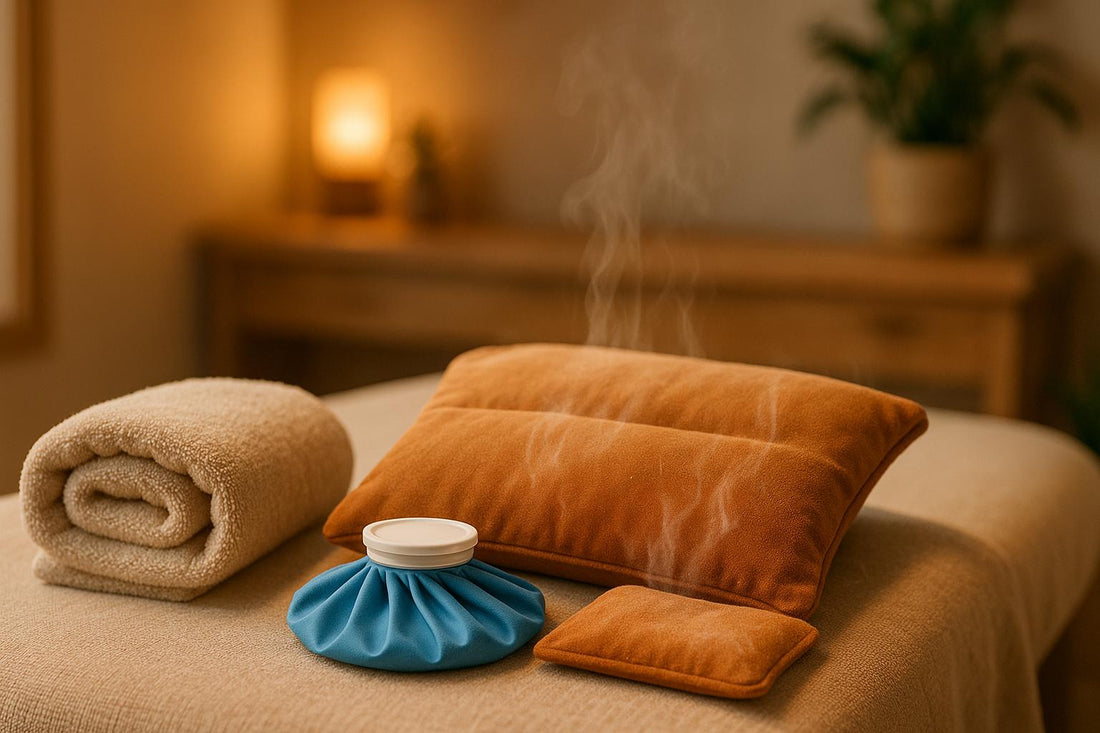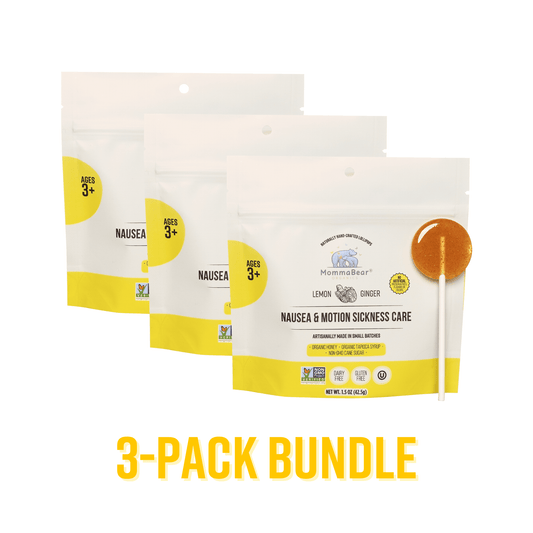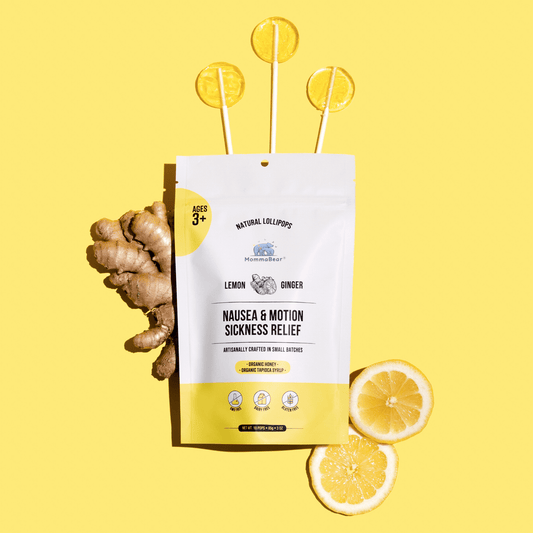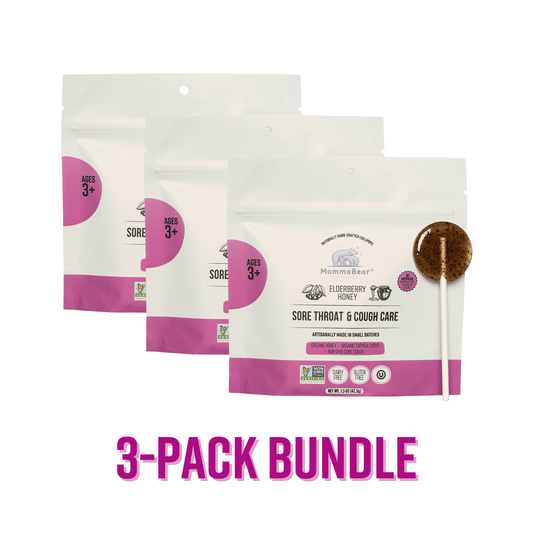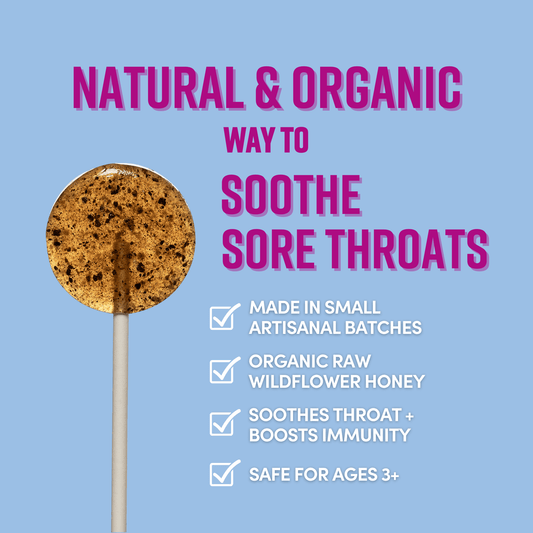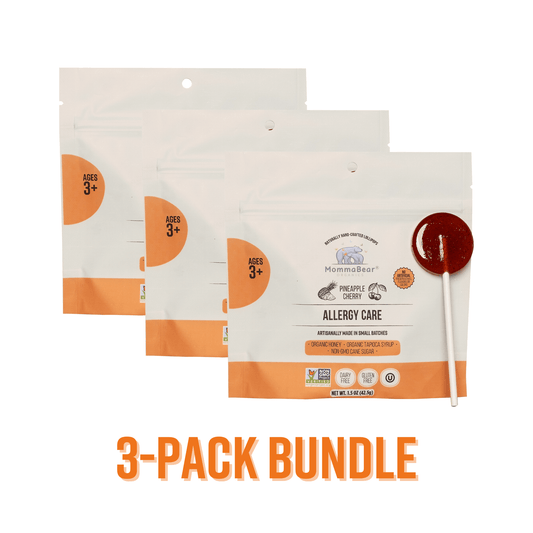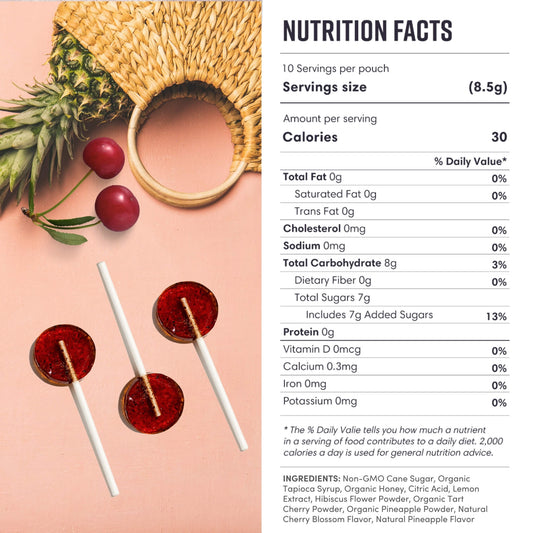Heat and cold therapy are simple, effective ways to manage pain and improve recovery after exercise or injuries. Heat increases blood flow, relaxes muscles, and eases stiffness, while cold reduces inflammation, swelling, and pain. Choosing the right method depends on your specific needs:
- Use heat therapy for chronic pain, muscle stiffness, or tension. It's great for recovery after inflammation has subsided or as a pre-exercise warmup.
- Use cold therapy for acute injuries, swelling, or post-exercise soreness. It’s most effective within the first 48 hours after an injury.
- Try contrast therapy (alternating heat and cold) to improve circulation, reduce soreness, and support muscle repair.
Quick Tips:
- Heat: Apply for 15–20 minutes using heating pads, warm baths, or compresses. Avoid heat for fresh injuries.
- Cold: Use ice packs or cold baths for 10–20 minutes. Avoid direct skin contact with ice.
- Contrast: Alternate 3–4 minutes of heat with 1 minute of cold for 15–30 minutes.
Each method serves a specific purpose, so timing and proper use are key to safe and effective recovery.
Recover Faster! How To Use Heat and Cold Therapy Effectively
Heat Therapy Benefits for Recovery
Heat therapy can be a game-changer for post-exercise recovery, especially when dealing with muscle tension and stiffness. By promoting physiological changes, it helps muscles heal and regain their function more efficiently.
How Heat Therapy Works
Applying heat to sore muscles or joints works by dilating blood vessels, which boosts circulation and delivers more oxygen and nutrients to the affected areas. This improved blood flow not only relaxes muscle fibers but also softens connective tissues, making joints more mobile and easing post-workout tightness.
Research has shown that local heat therapy can speed up recovery in several ways. It supports glycogen resynthesis, corrects vascular issues, enhances mitochondrial function, and even stimulates muscle protein production.
"When you warm up a sore joint or tired muscle, your blood vessels get bigger. This allows more blood, oxygen, and nutrients to be delivered to the injured tissues. Better circulation means more relaxation for those stiff muscles and joints." – Carolyn Sayre, Author
Studies also suggest that heat-treated muscles recover their fatigue resistance faster, as demonstrated by improved performance during repeated maximal contractions. These benefits can be achieved through various heat therapy methods.
Heat Therapy Methods
There are several effective ways to apply heat therapy, each catering to different needs:
- Heating Pads: Ideal for targeting specific areas of stiffness or tension. Use at temperatures between 104–113°F for 15–20 minutes. For more severe muscle pain, sessions can last up to two hours.
- Hot Baths and Warm Water Immersion: These methods provide full-body relief. Maintain water temperatures within the same range as heating pads, and soak for 30 minutes to two hours. Regular warm water therapy has been shown to reduce pain by up to 40% and improve mobility, particularly for arthritis and fibromyalgia sufferers.
- Warm Compresses: A simple but effective option for smaller areas. Soak a towel in warm water, wring it out, and apply for 15–20 minutes.
- Saunas: Great for relaxing deep muscle tissues and improving circulation. Always follow facility guidelines and listen to your body’s heat tolerance.
- Heat-Assisted Stretching: Applying a heating pad or hot water bottle to tight muscles for about 10 minutes before stretching can enhance flexibility and lower the risk of injury.
Heat Therapy Safety Tips
To make the most of heat therapy while staying safe, keep these tips in mind:
- Avoid Heat for Acute Injuries: Heat should not be applied immediately after an injury or during active inflammation. Wait two to three days to prevent worsening swelling.
- Check the Temperature: The heat should feel warm and soothing, not hot or painful. Use devices with automatic shut-off features and avoid falling asleep during use.
- Limit Session Duration: For minor discomfort, 15–20 minutes is typically enough. Gradually extend sessions for more severe pain, but don’t exceed two continuous hours.
- Stay Hydrated: Heat can cause fluid loss through sweating, especially when using saunas or hot baths.
- Consult a Professional: If you have conditions like diabetes, heart disease, or circulation issues, talk to your healthcare provider before starting heat therapy.
Cold Therapy Benefits for Recovery
Cold therapy is a go-to solution for managing acute injuries and reducing post-exercise inflammation. While heat therapy focuses on improving circulation and relaxing muscles, cold therapy hones in on inflammation and pain relief, making it especially effective for fresh injuries and sore muscles.
How Cold Therapy Works
Cold therapy, or cryotherapy, operates through a few critical processes. Applying cold to an injured or sore area causes blood vessels to constrict, which helps reduce swelling and inflammation - common culprits behind pain, particularly in areas like joints and tendons. The cooling effect also temporarily slows nerve activity, providing immediate pain relief. Additionally, by lowering the skin's temperature, cold therapy can dampen the inflammatory response and decrease metabolic activity in tissues, which is especially useful in minimizing long-term swelling when ice is applied right after an injury.
"Cold therapy helps reduce inflammation. It's most helpful when used for acute injuries and pain." – Healthline
By limiting fluid buildup in the affected area, cold therapy is most effective during the first 24 hours after an injury. Controlling this initial inflammatory response can help prevent lingering swelling.
"Ice therapy reduces swelling and pain in acute injuries by constricting blood vessels and inflammation." – Urban Ice Tribe
Studies also show that cold water immersion can ease delayed onset muscle soreness (DOMS) more effectively than passive recovery, making it a valuable recovery tool for athletes and fitness enthusiasts. These mechanisms highlight the practical applications of cold therapy.
Cold Therapy Methods
There are several ways to incorporate cold therapy into your recovery routine:
-
Ice Packs and Cold Compresses
Ice packs are a simple and accessible option for localized relief. Wrap the ice pack in a towel and apply it to the area for 10–20 minutes several times a day. For the best results, aim for 20–30 minutes of icing twice daily. -
Cold Water Immersion (Ice Baths)
Ideal for full-body recovery, ice baths are a favorite among serious athletes. Keep water temperatures between 51–59°F (11–15°C) and submerge for 11–15 minutes, or until you feel a slight numbness. A 2016 meta-analysis found that cold water immersion was more effective at reducing muscle soreness than passive recovery, both short- and long-term. -
Cold Showers
A practical daily option, cold showers can be added to your routine by ending your warm shower with a cold blast lasting 30 seconds to 1 minute. Gradually increase this to 5–10 minutes. Interestingly, one study found that office workers who took cold showers for 30, 60, or 90 seconds had 29% fewer sick days. -
Whole-Body Cryotherapy (WBC)
This method involves exposure to extremely cold air (below –148°F / –100°C) for 2–4 minutes. While some people find it more bearable than ice baths, current research suggests there’s insufficient evidence to prove its effectiveness in reducing muscle soreness in adults.
No matter which method you choose, it’s crucial to prioritize safety.
Cold Therapy Safety Tips
While cold therapy can be helpful, it’s not without its risks. If you have cardiovascular issues, respiratory conditions, or cold-sensitive conditions like Raynaud’s disease, consult a healthcare provider before starting any cold therapy.
Start slow - begin with 1–2 minute cold plunges and increase the duration gradually as your body adapts. For most people, 5–10 minutes per session is plenty. Be mindful of your body’s signals; if you experience dizziness, numbness, or uncontrollable shivering, stop the session immediately.
Afterward, warm up slowly using a towel or blanket instead of jumping into a hot shower. Stay hydrated, and if you’re a young athlete, make sure there’s someone around to supervise. Avoid cold therapy if you’ve been drinking alcohol or using drugs, and ensure the water is clean to avoid infections or skin irritation.
Dr. Andrew Jagim, a sports medicine expert from Mayo Clinic, advises against daily cold therapy throughout an entire season or training cycle. Research indicates it might interfere with long-term strength and muscle growth adaptations in athletes.
sbb-itb-e1a023f
Combining Heat and Cold: Contrast Therapy
Contrast therapy, which alternates between hot and cold water treatments, is a powerful way to enhance recovery. By combining the natural effects of heat-induced vasodilation and cold-induced vasoconstriction, this method improves circulation and supports muscle repair.
Rachel Stinson, Regional Director for FYZICAL Therapy & Balance Centers, describes the process as creating a "'vascular pumping' effect". This effect helps reduce inflammation, minimize swelling, and ease pain. Dr. Babak Shadgan, MD, PhD, a professor in the Department of Orthopaedics at the University of British Columbia, explains, "This process flushes out metabolic waste, such as lactic acid, while simultaneously delivering oxygen and nutrients to fatigued muscles. As a result, athletes experience reduced muscle stiffness, faster recovery, and improved functional performance".
The benefits of contrast therapy are backed by research. Studies show that contrast baths can help team athletes recover from fatigue within 24–48 hours after games, improving soreness and weakness more effectively than passive rest following intense workouts. Contrast hydrotherapy has also been shown to reduce swelling around three days after injuries like ankle sprains. A 2018 study highlighted how this therapy enhances healing by increasing tissue oxygenation and reducing swelling and edema. Additionally, a 2014 study found that contrast baths may be as effective as steroid injections in alleviating pain from plantar fasciitis.
By merging the circulatory benefits of heat with the anti-inflammatory effects of cold, contrast therapy becomes a key component of an effective recovery routine. It builds on the individual strengths of heat and cold therapies to create a more comprehensive approach.
What Is Contrast Therapy?
Contrast therapy is a type of hydrotherapy that alternates between hot and cold water immersion. This process creates a pumping action in blood vessels, amplifying the advantages of both temperature extremes while reducing the potential downsides of using only one method.
Contrast Therapy Protocols
For optimal results, most studies recommend using water temperatures between 95–113°F for the warm phase and 50–59°F for the cold phase. The typical cycle involves spending 3–4 minutes in warm water, followed by 1 minute in cold water, repeated over a 20-minute session. Sessions generally last 15–30 minutes and should always end with cold immersion to maximize anti-inflammatory effects.
Home Contrast Therapy Tips
Setting up contrast therapy at home is simple and effective. All you need are two large containers or buckets. Fill one with warm water at 98–104°F (37–40°C) and the other with cold water at 50–59°F (10–15°C). A digital thermometer can help you maintain the correct temperatures, ensuring both safety and effectiveness during your session.
Choosing the Right Therapy
Selecting the right therapy plays a crucial role in effective recovery. The choice largely depends on the type of injury, how long it has persisted, and your specific recovery goals. For maximum benefit, therapy should ideally be applied within one hour after exercise.
When to Use Heat Therapy
Heat therapy works best for chronic conditions or ongoing muscle issues. If you've been dealing with muscle stiffness, soreness, or pain for over 48 hours, heat is often the best option. The warmth boosts blood flow to the affected area, bringing oxygen and nutrients while helping muscles relax.
Heat therapy is recommended for:
- Chronic muscle pain that has lasted several days or weeks
- Joint stiffness, especially after inactivity or in the morning
- Pre-exercise warmup to loosen tight muscles and improve flexibility
- Muscle spasms or tension-related discomfort
- Lower back pain, particularly when paired with light exercise
Heat therapy can offer effective pain relief even 24 hours or more after exercise. For newer injuries like pulled or torn muscles, it’s better to start with cold therapy and transition to heat after the first few days. This approach helps balance inflammation control and healing.
When to Use Cold Therapy
Cold therapy is ideal for acute injuries and fresh inflammation. By reducing blood flow to the injured area, cold therapy helps minimize swelling and provides natural pain relief through numbing.
Cold therapy is ideal for:
- Acute injuries, such as sprains, strains, or muscle pulls, within the first 48 hours
- Post-exercise inflammation and swelling after intense workouts
- Fresh muscle soreness, especially from new or particularly challenging exercises
- Bruising and swelling, where controlling tissue damage is critical
Research indicates that lowering skin temperature to 59°F with cold therapy can effectively reduce swelling and inflammation. For athletes experiencing delayed onset muscle soreness (DOMS), applying cold therapy within an hour after exercise significantly alleviates pain.
Heat vs. Cold vs. Contrast Therapy Comparison
Here’s a quick breakdown to help you decide which therapy suits your needs best:
| Therapy Type | Best For | Primary Benefits | Key Limitations |
|---|---|---|---|
| Heat Therapy | Chronic pain, stiffness, pre-exercise warmup, injuries older than 48 hours | Increases blood flow, relaxes muscles, improves flexibility, eases joint stiffness | Not suitable for acute injuries with swelling; risk of burns |
| Cold Therapy | Acute injuries, fresh inflammation, post-exercise swelling, pain within 48 hours | Reduces swelling, numbs pain, limits tissue damage | Ineffective for chronic stiffness; may cause nerve damage |
| Contrast Therapy | Exercise-induced soreness, osteoarthritis, recovery during high-volume training | Boosts circulation, aids waste removal, reduces soreness | Requires precise temperature control; not suitable for all conditions |
For safe and effective use, apply heat or cold therapy for up to 20 minutes at a time, and always place a barrier between your skin and the ice or heat source. Keep in mind that cold therapy narrows blood vessels and reduces circulation, while heat therapy does the opposite by increasing blood flow.
Conclusion: Recovery Through Heat and Cold Therapy
Heat, cold, and contrast therapies are powerful tools for managing pain and aiding recovery. Each serves a unique purpose, addressing specific needs during the healing process. Contrast therapy, which alternates between heat and cold, blends the benefits of both approaches for a well-rounded recovery strategy.
Studies reveal that 67.8% of individuals dealing with chronic pain use heat therapy weekly, while 44.9% turn to cold therapy. Research also shows these methods can reduce delayed-onset muscle soreness (DOMS) in the lower back by nearly 50%. Dr. Edgar Ross, Director of the Pain Management Center at Brigham and Women's Hospital, highlights their importance:
"Both types of thermotherapy have important uses. What's key is that you use heat and cold therapy as a gateway therapy, not a passive one."
The key is staying proactive. Cold therapy is most effective within the first 24–72 hours after an injury, while heat therapy works best once inflammation has eased. Tailoring your approach is crucial - experiment with options like hot baths, heating pads, or ice packs to discover what works best for you.
For a more holistic recovery, consider combining natural wellness practices with your temperature therapy routine. Just as MommaBear Organics crafts organic lollipops to naturally address ailments like sore throats and allergies, integrating natural remedies into your recovery plan can provide added support. By combining these methods, you can enhance your recovery and work toward regaining peak performance.
FAQs
When should I use heat therapy versus cold therapy for an injury or soreness?
Choosing between heat therapy and cold therapy largely depends on the nature and timing of your discomfort or injury. For recent injuries - those occurring within the first 72 hours - cold therapy is your go-to. It helps by reducing swelling, numbing pain, and calming inflammation, making it especially effective for sprains, bruises, or other acute injuries.
After the swelling has gone down, you can switch to heat therapy. Heat works wonders for relaxing tight muscles, boosting blood circulation, and easing stiffness or chronic soreness. It's particularly helpful for muscle aches, tension, or joint stiffness. A simple way to remember? Use cold for swelling and heat for stiffness.
What are the risks of using heat or cold therapy incorrectly?
Using heat or cold therapy the wrong way can come with risks. Heat therapy, for instance, can cause burns, irritate the skin, or even make inflammation worse if applied for too long or at very high temperatures. On the other hand, cold therapy can lead to skin damage, frostbite, or nerve injuries if misused or left on for too long.
To stay safe, stick to the recommended application times and always place a protective layer, like a towel, between your skin and the heat or cold source. If you feel any discomfort, stop right away and reach out to a healthcare professional if needed.
Is contrast therapy effective for all injuries, or are there specific situations where it works best?
Contrast therapy works wonders for managing soft tissue injuries, inflammation, muscle soreness, and boosting joint mobility. It’s especially helpful during recovery from intense workouts or minor injuries. The back-and-forth between heat and cold can ease pain, reduce swelling, and improve blood flow, making it a solid choice for these types of issues.
That said, it’s not suitable for everyone. Avoid using contrast therapy on open wounds, infections, or if you have certain health conditions like cardiac issues, as extreme temperatures might aggravate these problems. If you’re unsure whether it’s right for you, it’s always a good idea to check with a healthcare professional.

